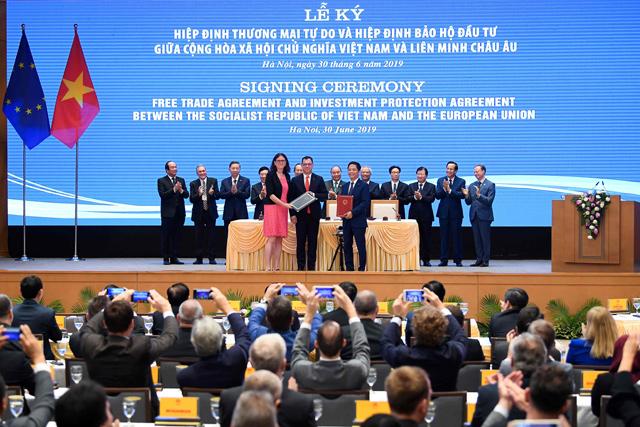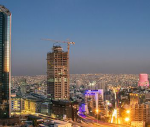You are here
Trade spat shifts business from ‘Factory of the World’ to other countries
By AFP - May 30,2019 - Last updated at May 30,2019

This photograph taken on May 24, 2019, shows garment factory workers making men’s suits in a factory in Hanoi (AFP photo)
HANOI — From socks and sneakers to washing machines and watches, Asian countries are hoping the US-China trade war will permanently boost manufacturing as brands dodge the row by choosing cheaper locations to make their goods.
Business has fanned out from China, often referred to as the “Factory of the World”, into Vietnam, Cambodia, India and Indonesia for years.
But the shift has accelerated as the world’s two biggest economies slap tit-for-tat tariffs on each other.
In the latest round of the bruising spat, US President Donald Trump this month raised tariffs to 25 per cent on $200 billion of Chinese goods, prompting Beijing to retaliate with higher duties on $60 billion worth of American products.
That “really became a kicker to force people to move”, said Trent Davies, manager of international business at the advisory and tax firm Dezan Shira & Associates in Vietnam.
A surge in relocations from China or plans to scale up production has strengthened the manufacturing hubs of Southeast Asia and beyond.
Casio said it was moving some of its watch production to Thailand and Japan to avoid the US penalties, while Japanese printer-maker Ricoh said it was also shifting some of its work to Thailand.
American shoe giant Steve Madden plans to boost production in Cambodia, and Brooks Running Company, Haier washing machines and sock maker Jasan — which sells to Adidas, Puma, New Balance and Fila — are all eyeing Vietnam.
The country is a logical move for manufacturers, wooed by low-cost labour, attractive tax incentives and close proximity to China’s unparalleled supply chains.
“It’s not just a result of the trade war, a lot of it is opportunity in Vietnam,” Davies said.
Boom times
Some Vietnamese suppliers say the trade dispute has fast-tracked the trend as companies scramble to dodge fresh tariffs that could affect some 4,000 categories of exports to the US.
On a busy stretch of road in Hanoi, the bustling Garco 10 factory is churning out men’s shirts for American brands like Hollister, Bonobos and Express.
The company says exports to the US were up 7 per cent last year, with an expected 10 per cent jump this year.
“Thanks to the trade war... several sectors of the Vietnam economy have gained, especially our garment sector,” Garco 10 director Than Duc Viet told AFP.
“We want to open more factories, we want to expand our capacity,” he said at one of his facilities where an army of workers made shirts destined for American shopping malls and department stores.
US imports from China during the first three months of this year reached nearly $16 billion, up 40 per cent from the same period last year, according to US trade data.
And that number could rise.
Labour woes
More than 40 per cent of US companies in China are now considering moving or have already done so, mainly to southeast Asia or Mexico, according to a poll this month from the American Chamber of Commerce in China.
But the shift is not expected to be seamless.
While southeast Asia offers low-cost labour — monthly factory salaries are about $290 in Vietnam and $180 in Cambodia and Indonesia, compared to around $540 in China — workers are less experienced.
“Labour costs are three times higher in China, but the efficiency is also three times higher,” said Frank Weiand, co-chair of the manufacturing committee at the American Chamber of Commerce in Vietnam.
There is also a smaller labour pool to draw on.
Vietnam employs around 10 million people in the manufacturing sector compared to 166 million in China, according to data from the International Labour Organisation.
Indonesia employs 17.5 million, and Cambodia 1.4 million.
Experts warn companies may also face supply chain woes, infrastructure challenges and land shortages in less developed markets without the capacity to absorb overspill from China.
Global shift
This could be a problem for Indonesia, whose bureaucracy has left it trailing some of its neighbours.
But now the country is hoping to soak up foreign investment from the trade war.
“We’re trying to make it easier for investors by speeding up the process for getting business permits,” said Yuliot, a senior official at the Indonesian Investment Board who goes by one name.
The country is also beefing up infrastructure and skills training while offering corporate tax breaks, he added.
With no end to the trade war in sight, analysts say the manufacturing shift out of China is likely to continue — and could redefine long-entrenched global trade patterns.
“Certainly it will end China’s dominance as the ‘Factory for the US’,” Gary Hufbauer, senior fellow at the Peterson Institute for International Economics, told AFP.
US companies and consumers may also get the short end of the stick: higher tariffs on goods out of China means the average American will likely have to pay more for a pair of Nike sneakers or Levi’s jeans.
If Trump was hoping to drive US manufacturers back home by imposing those tariffs as part of his “Make America Great Again” clarion call, he’s not likely to get his wish.
American industries — and wages — are not set up for low-cost manufacturing on the scale of China.
Instead, countries like Vietnam are likely to continue scooping up those jobs.
Le Thi Huong, who sews hems at Hanoi’s Garco 10 factory, said: “I hope there will be more orders... so we have more jobs and more income.”
Related Articles
AMMAN — The recent factory shutdowns are due to violations of regulations and laws, including tax avoidance graft, and have nothing to do wi
HANOI — The European Union and Vietnam on Sunday signed a long-awaited free trade deal that will slash duties on almost all goods, an agreem
HANOI/BRUSSELS — The European Union (EU) and Vietnam reached a free trade agreement on Tuesday, the EU's second in Southeast Asia, paving th

















